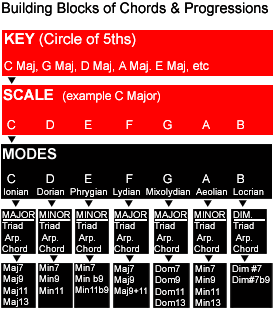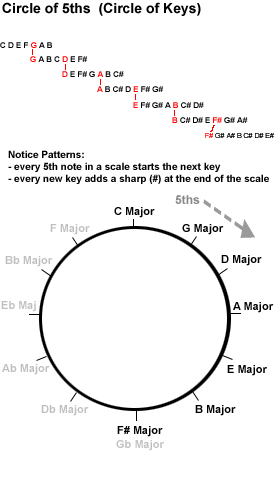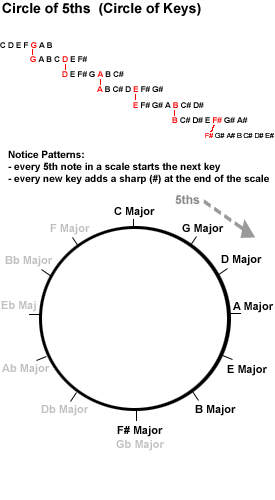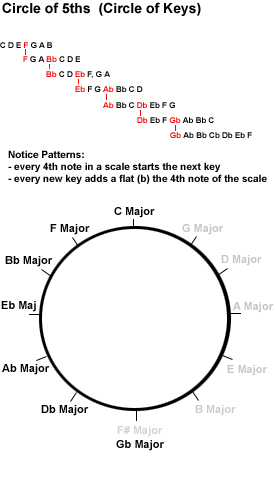Scroll through the lesson and click on notation/video/audio links to load the interactive players.
Please subscribe to get full access to all lessons for only $7.95/month PLUS 1 week free trial.

Riff Interactive lessons are
LESS expensive and
MORE interactive than alternatives!
More Info
|
|
| Lesson Subject:
Understanding Chords |
| What you learn:
Keys/Circle of 5ths |
| Teacher: Michael Johnson |
Michael: In
this lesson we'll cover the very fundamental stage of music, the "Circle of
5ths." This is the first step in establishing the KEY you play or write a song.

Michael:
This is the foundation for all music and is where the scales are based. Everything comes from this formula and
this is another piece of the puzzle to help you understand how music is
constructed. Here's a Circle of 5ths chart:
Circle of 5ths

hhill:
Sounds complicated
Michael: It sounds complicated, but you'll
understand once you can see it played on the guitar neck. If you notice everything starts from the
C Major scale, they all consist of "Natural Notes," which means you have no
sharps (#) or flats (b). Notice in the chart how you can build other KEYS,
everything starts with the C Major, C D E F G
A B.
Michael:
Now to build the next KEY, you'll move to
the 5th note of the C Major scale (G). When you do this the note sequence
will change a little bit, notice there is now the F# at the end of the G Major
(G A B C D E F#), they build on each other. OK, now I am going to show you on
the fretboard to help you visualize what is going on, this whole patter is
called Circle of 5ths. Each of these scale jump up a 5th each time
using the exact same Major scale pattern. First here's our starting pattern C
Major.
Michael:
I showed the octave of the G for a reason, now here's a pattern using ROOT notes
only they move in
5ths.
Circle of 5ths - Moving in 5ths

Michael:
The tab I gave you shows you the
positions of the Circle of 5ths scales on the chart. This will help you
visualize what's happening on the chart and neck. Now here are the scales
related to the tab and chart.
Michael:
Same MAJOR pattern, only moving up in
5ths.
ed: Ohhhh,
I see it now!
Michael:
That's how the notes all relate, this tab leaves the notes
up.
ed: Hmmm, is
that it. now it seems way to easy.
Michael:
Yes, it's as easy as that. Seeing it on the neck
helps. Many of these notes overlap, but this
should give you an idea of how it works. It might be easier to read the tab
notation when playing the scale patterns.
ed: Yeah
it does!
Michael: OK, let's go over the
rest of the Circle of 5ths. This pattern also works counter clockwise in 4ths,
where you add flats (b).
Circle of 5ths (4ths)

Michael:
Notice in this chart we start from the C
Major as well. You count to the 4th notes of the scale to start the next
KEY. Notice at the bottom of the formula the Gb and F# are the same, generally we use the 5th pattern more than the
4ths. Maybe the direction that relates to the clock as well has something to do
with the name. For instance most songs are in C, G, D,
A, etc. Here's the C Major tab for the 4th.
Michael:
To build this formula on the neck we will need to start from the octave position
of the C because we go down in 4ths and we run out of
fretboard.
Michael:
Here's the pattern going down in 4ths, this shows sharps (#) ,but it should
actually show flats (b). This application currently only show sharp notes, (A# =
Bb) (D# = Eb) (G# = Ab) (C# = Db) etc. Here's all the scale patterns for the
4ths.
Michael:
Here's with all the notes up, there is
overlapping, but it should give you an idea of the
positions.
Michael:
It's time to go. I hope you all walk away with a better understanding of chord
construction, good night all!!!
Dana: I sure do thanks teach
Glenn: great
lesson
emily: thank you teach
ed: Yeah
great job!
Michael:
bye!
|
<< load notation from left
|
|
<< load audio from left
|
<< load audio from left
|